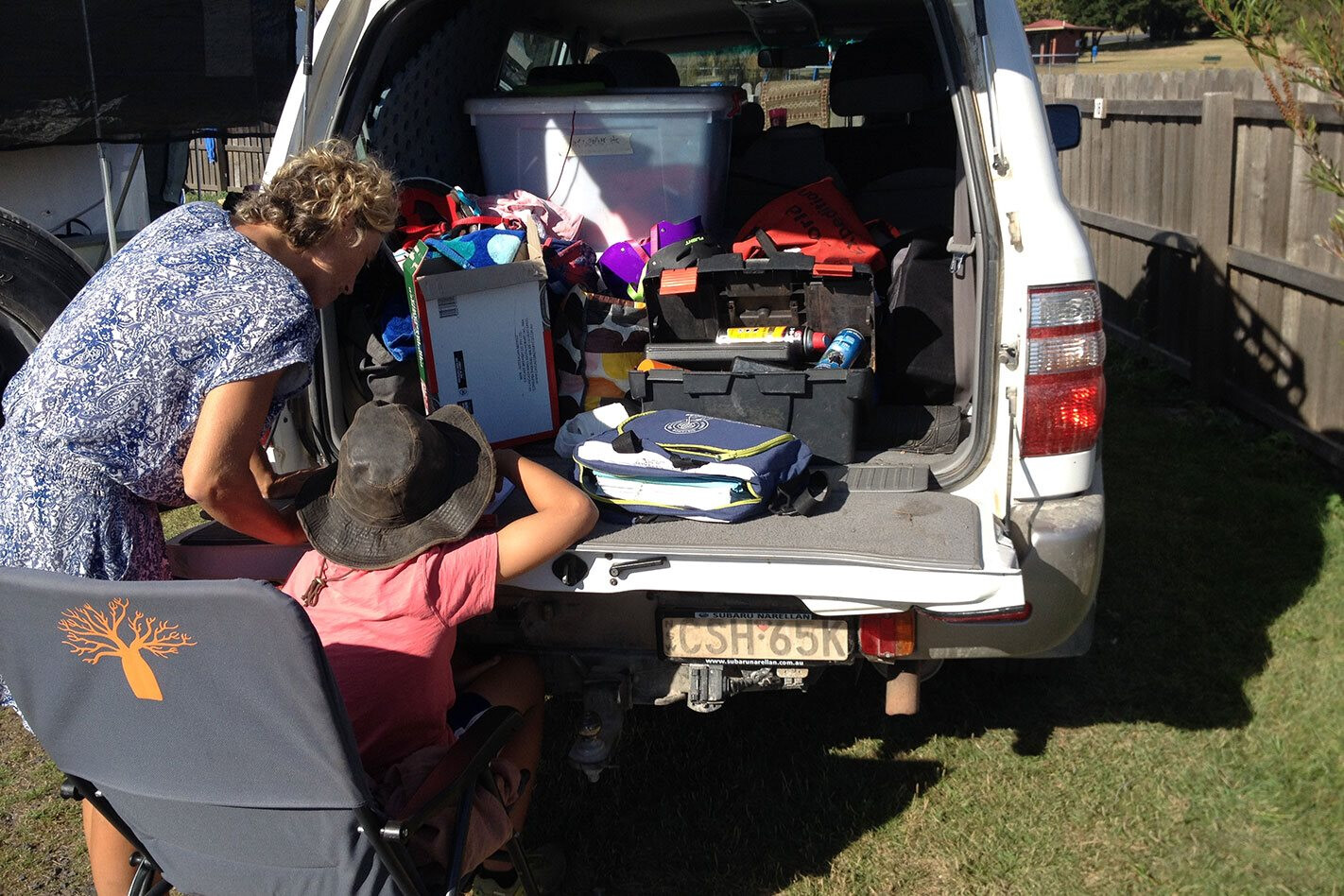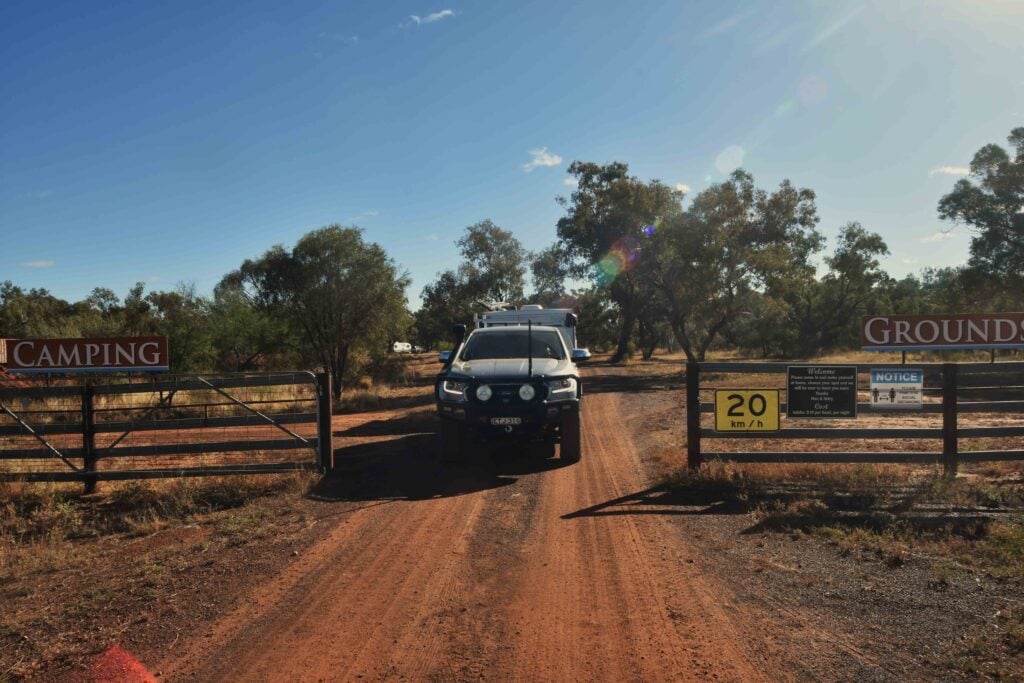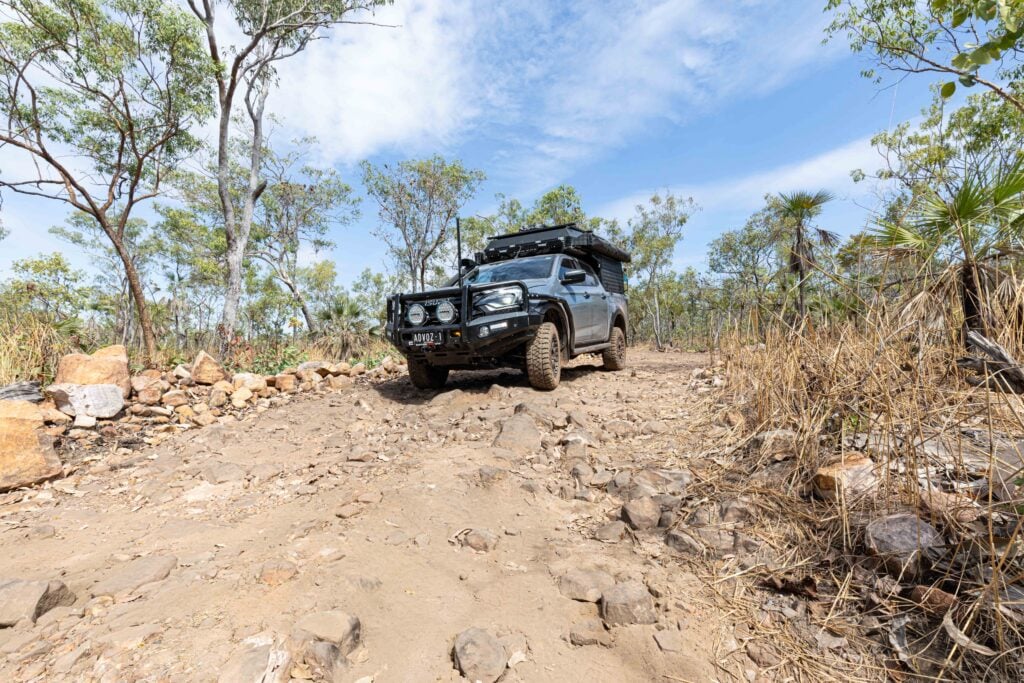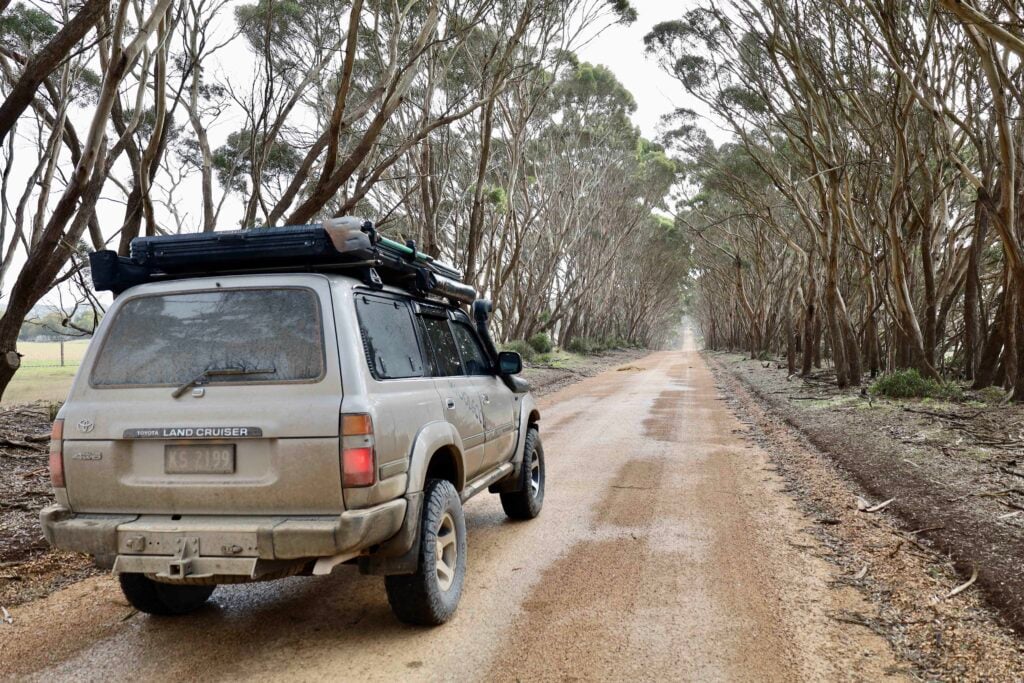School’s out for the day after the students have been up since 5.30am and in class since 6.30. It’s 27 degrees and not yet 10am and we’re camping in an area just a stone’s throw from the Coral Sea in Far North Queensland.
Already this morning, the five-year old read for an hour with mum in bed and then worked through handwriting technique on the camp table before doing some maths that had something to do with coloured blocks. The eight-year-old has been at a picnic table under the casuarinas rattling through his maths and journal so he can work on his major project: an illustrated comic combining much of the term’s curriculum, including embracing compound words, possessive apostrophes and the proper use of quotation marks. And the 10-year old just wants to fish, so he’s under the awning checking the work he toiled on late last night – project on sugar mills, as well as the obligatory maths and spelling – so he can fish the incoming tide before lunch. My wife is dipping into a novel and I’m preparing a ‘second breakfast’ of pancakes which we’ll devour before jumping into the hopefully stinger-less water for a cool-down before we plan the day. Bushwalk or spear some fish? Maybe we’ll do both?!
It’s paradise. Well, at least it is when it’s written down. The truth about travelling around Australia while schooling your kids is of course different and complicated. By some measures it’s even better than what is described above. By others – and at other times – it’s a nightmare.
First, the bad. Your kids never go home when the bell goes. They just put away their books and sometimes they don’t even do that. Any and all classroom conflicts continue throughout the day and may go into the night. When you envision most things, it’s without the extremes of temperature and the flies. And on the road, there is little room to hide. Climate control is certainly an issue as getting those assignments done in 40 degrees can be bordering on cruelty while in the mornings in the Victorian Alps, the kids are writing in mittens.
The rewards, however, can be lofty. Guiding your child towards independent study and analysis is a buzz. Conquering trigonometry problems together is fun. And the wealth of shared experience is irreplaceable: your inputs, your experience, your culture is totally shared. You are not only adjusting the airbags on the Land Cruiser together, you’re choosing the pressure for the terrain. Together you discuss lines of attack on tricky tracks, and the kids are superb scouts: jumping out of the cab and running up to check the state of the sand. They know as much about the lay of the land as we do because we all leant from the base: zero. Together you all discuss societal issues that crop as you drift around Australia: the state of the rivers, crops, the Indigenous people, pasture. You listen to the same audio books on the and tie it in with creative writing units from school. You know the kids’ units on marketing-speak, so when ads come on the radio, you all comment. You’re doing it all together. Everything.
If you’re hitting the road with your children, there are two major options: distance education; home-schooling.
Distance education
All state and territory governments provide distance education for students whose ‘special circumstances’ prevent them from attending school on a regular basis. Travelling within Australia is generally seen as one of these special circumstances. In a happy coincidence for those seeking travel as a lifestyle choice, distance education is maintained by states and territories to allow access and equity for people just like you.
New South Wales alone has 12 distance schools, some dedicated to correspondence like Sydney Distance Education High School, the School of the Air, and the Sydney Distance Education Primary School, while others like the Camden Haven High School, have a distance-education arm.
As more parents opt for travel as a temporary lifestyle, specialist schools further adapt. Broken Hill’s School of the Air was established in 1956 to cater predominately for the geographically isolated students within a radius of approximately 300km. Over the last two years, however, students who come under the category of ‘travellers’, have also been enrolled.
We chose distance education (Sydney Distance Education Primary School, SDEPS) because the New South Wales regulations on home-schooling (see the below information) were frankly too demanding. SDEPS do so much of the work for us. The structure of this sort of distance schooling is based around a conventional classroom approach (SDEPS is even located in a decommissioned primary school in inner Sydney, so it’s actually a concrete school just minus the screaming kids). Each child has a teacher and classmates (that they may get to know through projects and online). We (the parents) are not the teachers, but we are the ‘supervisors’.
Like most distance education schools around the country, SEDEPS works in a number of ways: paper-based, phone, Skype, electronic audio files, video, and iPad are some of the tools used. But the basic recipe goes like this: each child enrolled receives a giant envelope at the start of each term. In that bubble-wrapped monster are library books tailored to each child’s level and interest, resources you might find in any classroom such as protractors and compasses, and clearly marked folders, each with two weeks’ of lessons complete with attendance sheets, lesson summary guides, and supervisors’ notes.
Our 10-year-old was keen to join the iPad generation and slotted quickly into a trial of sorts, where almost all work was done on an iPad which needed to be regularly synced (saved and uploaded) to the SDEPS system so the teacher knows exactly where he is and how he’s going. He can watch videos of his teacher outlining strategies and explaining concepts. He can fill in worksheets by typing or writing with a stylus on screen.
The issue with this online system is obviously internet access. But by working and saving onto the iPad and then syncing when there is access, that issue can be overcome.
There is also the entirely paper-based system. For some people this is easier and we certainly found that planning lessons and workloads was more straightforward when you could spread everything out in front of you and shuffle it around. In the giant envelopes received from school, there are reply-paid addressed stickers to any work and resources. We find this system the best with our two younger children. If we’re flustered, we can always find a worksheet or text to occupy them. There are no hidden tricks, just work through the folder, and chuck the bits of paper you didn’t finish into tomorrow’s pile.
No matter what technology style you choose, your distance teacher will need direct contact with their student. They need to watch and/or hear them read and write. They need to talk to them about their work so they can get a first-hand understanding on how they are doing and ensure they are working and thinking independently.
SEDEPS supply and help you to install simple audio-recording software and systems to transfer large electronic files. It’s part of their classroom brief so the school takes a good deal of ownership of this process.
The old and the new
- Hotspotting. Most smartphones have the ability to act as a ‘modem’ for your laptop or iPad or other device. You’ll need to go into ‘settings’ or similar function and investigate.
- 4G modems. Expensive but fast and versatile, you can choose to have fast and reliable internet anywhere a Telstra signal is obtainable.
- The old Post Office. Your mail can be sent to you care-of any post office in Australia. It is an oddly thrilling process to pick up your bubble-wrapped education goodies at a post office in a town you picked on the map because you knew you’d be motoring through it.
Home schooling
While state and territory governments support parents’ rights to educate their children, ‘school’ remains compulsory. That means that, to varying degrees, states reserve their right to ensure your ‘teaching’ is not ad-hoc and irrelevant. You will need to apply for and be granted registration to teach your child. If you want to take this ‘home-schooling’ route, it is certainly not the easy way out.
Don’t expect to hit the road and to make it up as you go along – pointing out bits and bobs of information that occur to you along the way. The fact that you and your kids might be having a ball and catching fish and talking about weather patterns is not formally of interest to the education authorities. Children need to be achieving certain standards and ticking boxes, so home-schooling is not the easy option.
As usual, the details differ from state to territory. NSW and Queensland have the strictest documentation guidelines for registration. You might expect to submit an application for each child you would like to home school. This application may need to include an educational program, learning philosophy or curriculum that has been developed or adapted by you or by a registered teacher. This program may be very detailed, and it will certainly be closely examined by your state or territory education department for its pedagogical relevance and coherence.
Victoria is the simplest – you really just need to fill out a form and notify the Victoria Department of Education. The other jurisdictions fall somewhere in the middle of the spectrum. Registration in Western Australia includes a visit from a moderator and evidence of a learning program based on the WA curriculum framework. In the ACT, you will need a learning program but it doesn’t need to be based on a set framework. In South Australia you need to provide a broad overview of your learning program including eight key learning areas that mirror the National Curriculum; you will also be visited by an official. In Tasmania, you won’t be visited but the Tasmanian Home Education Advisory Council will handle the application. In the Northern Territory you are granted an interim registration which will be approved (or rejected) later by a moderator.
Add to all the above is the fact that you’ll probably have to repeat the process to continue in a new year and you may need to provide a report that demonstrates the educational progress of any children you are schooling. So consider that if you’re trip will go over into another year. On the bright side, proof of registration from one state or territory is recognised throughout Australia, so you won’t have to reapply each time you cross a state border.
And there is plenty of help available. There are numerous homeschooling support groups that can offer advice, support and companionship for children as well as parents. An online search will turn these up easily. For instance, Home Education Australia is not-for-profit volunteer association encouraging and promoting home educating in Australia, and providing members with benefits – hea.edu.au.
The major reported benefit of homeschooling while travelling is the magic of tweaking the curriculum for circumstances and place, and of course workload management. If you’re in Port Arthur, looking into colonial Australian history is obviously perfect. When you’re in the Daintree, ecology would be a nice touch, as are indigenous culture and mining issues in the Top End. The dovetails can be fascinating and fun.
Our own style
We are halfway through a year-long odyssey, and our major discovery is that there is no magic formula to make school easy. Nothing is new. Here are some of our tips which you may well have seen in other settings. We have travelled for a time with a family who ignored weekends. Each day was a school day. That’s just part of the deal. We have found the weekends provide the structure we and our kids enjoy.
- Start early. When you’re not making school lunches or running off to work yourself, it makes sense to get into it straight away. Kids usually wake early and have energy in the mornings. Harness that and go hard early. Especially in the heat.
- Reward. When school has finished for the day, there needs to be some change or reward to signify that. Snack time, play time, fishing time, swimming, it’s up to you.
- School is business. We have met parents who wear different clothes when working through school with their kids – when school’s out, off comes the tie.
- Work space. You need to have a system for storing schoolwork and for both you and your children to concentrate. This can of course be difficult, so be creative.
- Get buy-in. Sometimes it can be beneficial to have the kids plan the lessons. Let them take ownership and dream up rewards. If they are planning the courses, their navigation might just work superbly.
- Libraries are your friend! Wi-Fi, enforced quietness, air-con … paradise.
Education and training contacts
ACT: det.act.gov.au
NSW: schools.nsw.edu.au
Northern Territory: education.nt.gov.au
Queensland: education.qld.gov.au
South Australia: decd.sa.gov.au
Tasmania: education.tas.gov.au
Victoria: education.vic.gov.au
Western Australia: education.wa.edu.au
Get the latest info on all things 4X4 Australia by signing up to our newsletter.





